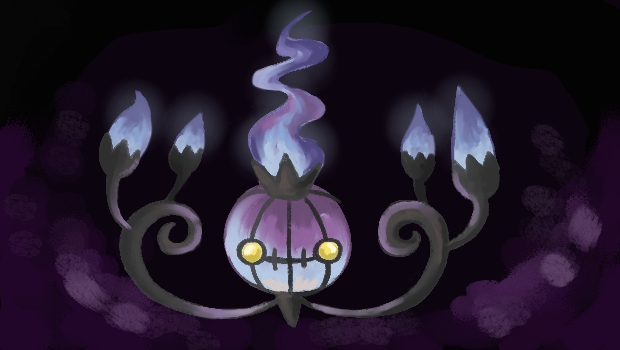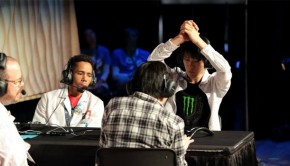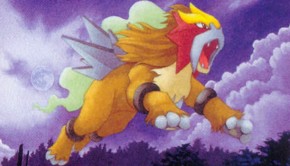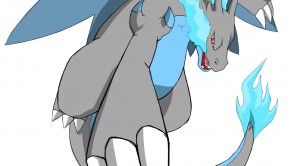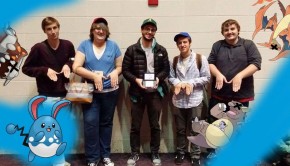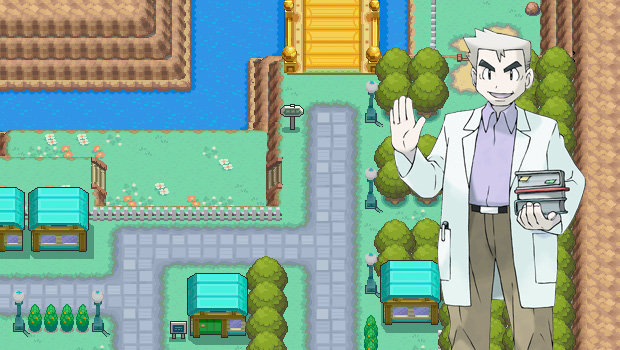Can’t Stand This Glacial Pace: 2012 VGCS Winter Battle Team Analysis
Article image created by feathers for Nugget Bridge. View more of her artwork on her tumblr or Nugget Bridge forums thread.
Hello. Have you ever played in the GBU, not counting our beloved 4-day tournaments? If yes, you might have already encountered a team which looks like this:
![]()
![]()
![]()
![]()
![]()
![]()
This is obviously a pretty archetypical Hail Room team which Japanese people seem to use a lot. That’s what I believe, at least, since I’ve met so many different yet alike of them I’ll never forget about it. I concede that it looks so mindbogglingly simple that everyone could come up with it and a sixth mon in less than 10 minutes, but let’s label that coincidence. Let’s label that coincidence because the lineup actually makes sense — makes so much sense that it can be interpreted pretty effectively despite being inherently predictable. Looking at the bare Pokémon, we can determine: Chandelure and Jellicent are the Trick Room setters of choice — both being immune to almost every Fake Out, with Chandelure being more offensive and Jellicent being more durable. Hitmontop and Amoonguss help to set up the Trick Room (Fake Out or Rage Powder) and can support the team beyond that (most notably Feint, Helping Hand and Spore). Abomasnow is (one of) the main attacker(s) and, well, no Hail Room without Hail, I suppose? The sixth slot is a different story, the Pokémon I’ve seen in there could possibly belong to any of these three groups. I’ve seen Bronzong or Reuniclus also possibly summoning TR, I’ve seen Gastrodon, Metagross or Glaceon for simple attacking purposes, and I’ve seen Togekiss as a third supporter, Minimize Blissey for whatever reason and so on. (Personally, I prefer the attacking route there.) Also, they are all rather slow, which obviously goes well with Trick Room.
So, you see, it just does make sense. There are two main points that have made me try it out myself: First Amoonguss or Fake Out alongside a Ghost is pretty much a guaranteed setup — there’s not much beyond Ghost-Imprison, Rock Slide flinches or Blizzard freezes that still prevents the setup. Second, the involved Pokémon happen to have good offensive coverage with each other, while the defensive synergy isn’t too bad either. I saw much potential in it, and with the experiences I have under my belt now, I’m certain that it is one of the best ways to run full Trick Room.
Team Building Process
I started theorymonning with the team just as you are seeing it up there, while still fighting some variants of it over and over again. The failures — if I may call them so — of my opponents revolved largely around Hitmontop and Amoonguss. They had a habit to bring them both together to battle and sometimes I would happen to knock out their other two first so that they had only Amoonguss and Hitmontop left, which is a huge bottleneck. Hitmontop couldn’t do much on his own without the opposition sleeping appropriately but Amoonguss wouldn’t be able to Spore them without having Hitmontop killed at the same time. Apart from that, I’ve played Hitmontop way too much over the season — so much that I’ve actually begun to dislike him.
Another reason Hitmontop was left out of the team is that Hitmontop is rather defensive and thus does work well in more defensive teams, but interpreting this very team in a defensive way wouldn’t have gotten me anywhere. That’s what some of my Japanese opponents have tried to do, after all. So, as I knew my overall defense certainly wouldn’t be airtight (pun intended, do you already get it? ツ), I figured I just wanted to go brute-force — enter Hariyama! It can fulfill Hitmontop’s supporting role to a sufficient extent, it has better base speed for use in Trick Room (Hitmontop’s 70 is just awkward sometimes; it starts with possible speed ties with Metagross or Politoed and then there’s also Tyranitar which can linger on any side of the speed scale) and it isn’t limited to a single strong blow. Sleep immunity can also come in handy.
Obviously, I still need to cover the question mark. I started with Glaceon there, just for the coolness factor. Though, I actually knew from the very beginning that Glaceon and Hail Room simply doesn’t work, practice has confirmed it, as I picked Glaceon not a single time over the course of about 20 battles. Read why: First, there’s about no point in bringing Glaceon to battle without Trick Room or Hail up. Trick Room may be debatable, since Glaceon does have some bulk to excuse its awful defensive typing, but no Hail means no reliable Blizzard spam. (Remember: Glaceon still packs the strongest Blizzard in the game, excluding Kyurem.) Second, there will be no Hail without Abomasnow. Abomasnow and Glaceon together in a team of 4 leads to a pretty annoying accumulation of shared weaknesses and in addition, they just have no offensive synergy together bar Hidden Power shenanigans. Finally, their dependence on a low-priority setup whose effect lasts only 4 turns delivers the coup de grâce. If I really wanted to play two Ice types together, I’d at least abstain from Trick Room — just as Huy did successfully.
Thus, a new sixth mon needed to be found. The requirements were pretty simple: It should be able to deal with Heatran, which is an obvious threat to the team, and it should just be beneficial to the team’s success in general for whatever reasons, so I’d get to pick it more often to begin with. My biggest candidates then were Gastrodon, Hydreigon and Empoleon. Gastrodon obviously just makes sense, it fits the Trick Room theme, has beneficial typing and if I felt bold, I could even have Jellicent pump it up with Surfs. In the end, I decided against it because I wanted to keep Water Spout and I just wasn’t in the mood for Gastrodon at the time. Besides, Gastrodon’s natural synergy with Trick Room is also a disadvantage in the big picture: It makes the team roughly just as predictable as it has been before. Empoleon was a pretty interesting idea, since it has been basically forgotten since San Diego ’09 but packs one hell of a movepool together with one of the coolest defensive typings ever made. Again, Empoleon also didn’t make it into the team because… because I was too lazy, it’s really as simple as that. I haven’t yet ruled out Empoleon completely but Hydreigon just was accepted into the team first because I knew perfectly what it would and what it wouldn’t give me. Hydreigon is the Pokémon I have used the most during this generation, having owned five different variants of it and got the sixth particularly for this team. And not to forget, my three absolute favorite Pokémon are Moltres, Ho-Oh and, yes, Hydreigon. Well, let’s have a look into the team’s details, then.

![]()
![]()
![]()
![]()

The Final Team (for the Time Being)
![]()
Chandelure / Skelabra / Lampedusa
Modest, Flash Fire, ♀
188 HP, 20 Def, 252 SpAtk, 28 SpDef, 20 Spe
@ Focus Sash
~ Shadow Ball
~ Heat Wave
~ Trick Room
~ Protect
The moveset is a basic Trick Room Chandelure, I guess. Shadow Ball is the obvious Ghost STAB, and I have never seen a Chandelure that didn’t have it. Trick Room because the team wants it to be set up, Focus Sash for securing the set up against super effective or simply very strong STABs, and Protect is needed for having better control over when Chandelure gets hit or not — sometimes I’ve even used it for stalling out my own Trick Room, since Chandelure is easily undersped but deadly if it’s striking first. Heat Wave has become my Fire STAB of choice simply because I deem it the most useful. Flamethrower is rather harmless by hitting only one foe with little more force, Fire Blast is even more unreliable in terms of accuracy and I don’t appreciate the -2 that Overheat would give me. Also, Heat Wave just fits the team’s style in general.
The EVs are also not far from standard TR Chandelure, but I went with Modest because I wanted to outspeed Metagross outside of Trick Room. Maximized special attack for obvious reasons and the defensive side of things looks this crazy just because I’ve made the total HP plus one divisible by 16 so that residual damage via Hail would be minimal. I’m bringing Abomasnow to most of my battles so it’s a pretty likely possibility that Chandelure has to cope with weather and with it surving random attacks usually around the yellow/red fringe of the bar, every point does matter.
Let’s have a closer look at Focus Sash again. The superficial mind would instantly consider this contradictory with my own weather and advise me to use a Gem or something else instead. Though, as mentioned, it’s needed for the setup against hard hitting foes and even after being triggered, it still isn’t yet the end of the line for Chandelure. A good example is Cresselia: If people have her in their team, they usually also pick her for battle. Usually, Cresselia doesn’t have Protect. Adding 1 to 1, here’s a pretty realistic scenario: T1 get Trick Room up, T2 switch Chandelure out for Abomasnow, then chip away at Cresselia with all the multi-target moves but focus on the other three of their team. Finally, Cresselia ends up isolated or with a useless partner and then, after a knockout on my own side, Chandelure is threatening to get an unavoidable Shadow Ball in even though it’s sitting at 1 HP in damaging weather.
On another note, I disliked Chandelure almost as much as Hitmontop starting into playing with this team, because whenever I played it before, it was usually the Pokémon I picked the least of all. This team, however, is different: Chandelure fits just perfectly into the concept in every way — it’s the Pokémon I picked the second most during the Winter Battle, only behind Jellicent. A striking reason for that is Chandelure’s typing: Fire always goes well with Ice as Ghost goes well with Fighting — and this is just a small example for overall great synergy. I’m really happy to be finally able to state that the oh so mediocre Chandelure was indeed great. A Pokémon looking this awesome deserves no less.

Jellicent / Apoquallyp / Lethe
Relaxed, Cursed Body, ♀, ★
252 HP, 236 Def, 20 SpDef
@ Water Gem
~ Water Spout
~ Blizzard
~ Trick Room
~ Recover
My second Trick Room setter — the one I like to have around for a bit longer, which is made possible by Recover and Jellicent’s good overall bulk. Water Spout is usually the best Water STAB for simply hitting hard and Blizzard for obvious coverage. Ice Beam should be very playable there as well, I guess — it would be overall weaker but it would care neither about the weather nor Wide Guard. The Water Gem is needed for Water Spout not being too weak because of the defensively oriented stats. It has so often made the difference between KO or no KO on weakened foes with neutral typing and full-health Fire types alike that I would never trade it for the more reasonable-sounding Leftovers. Finally, Cursed Body is without a doubt Jellicent’s best ability, often denying foes their best attacks. (Remember: Cursed Body works on all attacks, not just those making contact. I wonder if that’s actually what Game Freak wanted or if it’s an error…)
The EVs and nature simply maximize Jellicent’s overall bulk, though this extreme focus on the physical side does have some great impact: Tyranitar. It’s vital for the team’s success that Jellicent is able to survive Tyranitar’s Crunch in a pinch (67-81% damage with this spread) so that it can set up (a second) Trick Room to create a more comfortable field. Special attacks, on the other hand, still don’t OHKO, with Timid Latios’s Draco Gem Meteor peaking at 88% and Modest Therian Thundurus’s unboosted Thunderbolt peaking at 95%. Unfortunately I do need Jellicent to speed tie with my own Abomasnow because they cannot underspeed Brave Tyranitar by more than a single and very important point and running level 49 on one of them is not an option I’d seriously consider just for this.
![]()
Abomasnow / Rexblisar / Yeto
Quiet, Snow Warning, ♂
60 HP, 196 Atk, 252 SpAtk
@ Ice Gem
~ Blizzard
~ Wood Hammer
~ Ice Shard
~ Protect
Abomasnow (or do you favor Abomakraut?) is pretty much my main attacker — whenever I get to show it, it usually knocks out one or two of their Mons and dents whatever else it hits with Blizzard in the process. Ice Gem is used because I often switch Abomasnow into Earthquakes, Thunderbolts, weak neutral attacks etc. which would render a Focus Sash useless and besides, I like having one super-strong Blizzard at my disposal. (Random and unfortunate, if not straight obnoxious fact: special-defensive Thundurus still has a chance to survive it…) Protect and Ice Shard are just as standard as Blizzard, the former for… well, protecting Abomasnow, and the latter providing some priority that may pick off some weakened foes when Trick Room is gone (like that special-defensive Thundurus). As for the Grass STAB, I highly prefer Wood Hammer because Giga Drain is so shamefully weak that it doesn’t even OHKO non-Rindo Gastrodon for sure, and then there’s Tyranitar in his own beneficial weather, where Giga Drain is just… bad. I like Wood Hammer very much for actually OHKOing or at least severely damaging all stuff weak to it and apart from that, neutrally hit foes don’t enjoy this relentless 120-power strike either.
The EVs do reflect this plan, since some attack is needed to make Wood Hammer powerful enough to not get stuck at dark-red HP bars too often. Ice Shard also gets a bit more powerful and with Trick Room, Hail and Protect in the mix, every point can matter. Special attack is maximized for sending the best possible Blizzards from the heavens, obviously, and the few additional HP achieve that Scizor’s Bullet Punch doesn’t OHKO at full health.
Why am I considering Abomasnow my main attacker and not just my weather setter/changer? First, there is no team member apart from Jellicent and Abomasnow itself that benefits from Hail, so I could probably do well enough without it. Second, while Ice is often resisted, it’s also one of the most common weaknesses. Landorus, Hydreigon, Garchomp, Salamence, Thundurus, Zapdos, Latios, Amoonguss, Togekiss, Virizion … all loathe STAB Blizzards and many people tend to have 3 of them in a single team. Then there’s some stuff Ice is neutral to which I don’t care too much about for proving my point and then there’s also a few resistances, usually partly Steel, Water or Fire. Water Pokémon are the easiest to break, as Wood Hammer does just that whereas (if bulky) they still can’t even threaten Abomasnow on their own most of the time. Fire and Steel are the types that Abomasnow doesn’t enjoy fighting as long as they are not frozen, but Hariyama, Jellicent, Chandelure and to a lesser extent Hydreigon all do a very good job taking care of them. Great synergy is what makes Abomasnow as deadly as it is here.
![]()
Hariyama / Tam-Pong
Brave, Guts, ♂
28 HP, 252 Atk, 212 Def, 12 SpDef
@ Toxic Orb
~ Fake Out
~ Close Combat
~ Rock Slide
~ Detect
Hariyama is one of my two Mons that help set up Trick Room or can buy me time for general purposes, but Hariyama in particular also is another big attacker or, put more conventionally, my trusty glass cannon. Fake Out does said set-up-buy-time stuff (hey, it’s actually Hariyama’s signature move, being based on a sumo wrestler!) and is also a ridiculously strong limited-use priority move once status-afflicted; Close Combat is its best STAB without question; Rock Slide for coverage (I don’t think I’d need Ice Punch in an Ice-heavy team like this and I just hate Volcarona any day); and Detect, well, is also for buying time in a different manner, since Hariyama does magically attract a good share of hate just by standing there. This is the case because of Toxic Orb — the peculiar drug that nobody would begrudge it but that makes it so insanely dangerous simply by activating Guts. Toxic Orb is preferred over Flame Orb because Toxic Orb would need at least 4 consecutive turns of Hariyama being active (not even counting the turn of activation) to be more harmful in total, which rarely ever happens. Switching Hariyama out to reset the Toxic count (and also gain a fresh Fake Out or the mere threat thereof) is also helpful.
The EVs are made to attack as heavily as possible, of course, and to survive Metagross’ unboosted Zen Headbutt in addition to 1/16 residual damage for sure. Moreover, residual damage is minimized — there’s no Pokémon where it matters more, as strong neutral STABs usually leave Hariyama in the yellow range, for it to be able to live through Toxic and Hail a few turns and a Guts-boosted Hariyama with zero or one HP is a gargantuan difference! The few remaining points have been dumped into Special Defense even though I’m sacrificing a point by doing that just because I didn’t want to neglect the special-defensive side completely (my personal notes tell me no different at all).
Also, don’t use Flame Orb Conkeldurr. At least not as long as Hariyama is in the format.
![]()
Amoonguss / Hutsassa / Mihiip
Sassy, Effect Spore, ♀
252 HP, 180 Def, 76 SpDef (Spe-IV 2)
@ Occa Berry
~ Giga Drain
~ Spore
~ Rage Powder
~ Protect
Sporprise, Sporprise, there’s a Humoonguss Foonguss Amoonguss! Giga Drain for generic STAB, Spore because it would be weird not using it, Rage Powder for supporting my Trick Room setter or just a strong attacker and Protect fulfill a completely bog-standard set that everyone should be familiar with by now. The EVs make it stable against all types of attacks but aren’t really specific. Effect Spore is an ability I really not suggest to use in a Trick Room context — I used it here just out of laziness and it did backfire a few times by paralyzing foes that must not be paralyzed whereas the poison and sleep effects still didn’t win me any battles. Thus, Regenerator is obviously superior here. The item should probably be a Mental Herb for shielding the team from Taunts better, but I really don’t know for sure.
Well, let’s be honest: Amoonguss, I don’t like you. You’re doing fine against plenty mid-tier players that are not prepared for you but better players usually know how to knock you out in an instant or just make you living dead weight. I have enough reasons to kick Amoonguss straight out of the team, but then what? Amoonguss is pretty much my insurance for having ways to force the Trick Room into play against anything that isn’t Imprison or bad luck, so replace it and then simple Fake Out + Taunt combos will be having a field day. I would like to try Togekiss or something for doing the same attention bumming and punishing “over-Protective people” with Encore, but I do not appreciate its Rock and Electric weaknesses either…

Hydreigon / Trikephalo / Dinodora
Modest, Levitate, ♀, ★
28 HP, 4 Def, 252 SpAtk, 4 SpDef, 220 Spe
@ Dragon Gem
~ Draco Meteor
~ Dark Pulse
~ Earth Power
~ Protect
And here’s that one Mon that enables an otherwise rather predictable team to change its plans mid-battle. Dragon Gem Meteor is the usual well-known guaranteed knockout if it hits. Dark Pulse for having a more reliable STAB without penalty, it’s also helpful against Psychic- or Ghost-types, OHKOing Chandelure for sure. Earth Power is obviously chosen because of Heatran, though it’s somewhat ironic that each and every one of them I’ve hit with it fed on a Shuca Berry. Finally, I think Hydreigon with its countless enemies shouldn’t be used without Protect if not holding a Choice item, so it’s there. It’s also useful for controlling Trick Room a bit, as Hydreigon’s effectiveness heavily depends on the field it’s on. The EVs are standard offensive with Timid Chandelure as the target to outspeed.
I may have told you why I went for Hydreigon, but I have yet to tell you why it’s so good. Again, it’s another glass cannon and it’s one that doesn’t even fit the team’s concept at all. Thus, it allows me to break out of the concept and simply murder something out of nowhere, usually giving me a quantitative advantage that makes it harder for my opponent to deal with the concept when it’s eventually played out. This works particularly well against people that play rather defensively and/or don’t have many checks to Hydreigon, though I think I might even try it more against people full of those checks to provoke some early misplays.
Hydreigon is a gamble, but it’s one that has never disappointed when I put my faith into it. I can flesh this out with imposing facts: I haven’t lost a single match with Hydreigon in the group of 4 during the Winter Battle. Adding other battles, I have only lost one with it, which was game 1 of a best-of-3 set and I also picked Hydreigon for game 2 and 3, from which I emerged victorious. One can say that I am fatefully bound with my Hydreigon also known as the infamous Dinodora Clan, and this one you’re looking at right now is the sixth of them.
Cutting 6 Down to 4
I’ve already written quite much about the synergy in the individual Pokémon’s texts, so I’m omitting a section dedicated to it and focus just on the foursomes that are brought to battle instead. My records tell that I’ve picked 15 (!) different during the Winter Battle, which is perfect proof that the team features a healthy share of versatility and no 1-to-1 dependencies at all. In this article, I’m only introducing 3 of them, because the abstract ideas behind them are to be shown and most of the other 12 look similar to one of the following, often just substituting 1-2 slots with other Pokémon playing the same role.
![]()
![]()

![]()
The Core: Chandiyama and Jellisnow
This is the very basic Trick Room lineup. Out of all 15, I’ve used this one the most by far, with the corresponding Amoonguss (instead of Hariyama) variant being used second most, but not even half as much — added together, I fought about half of my battles this way. It’s pretty intuitive how it works: Get the Trick Room out turn 1 or turn 2, take out or soften up as much stuff as possible during the next 4 turns with the help of all the great synergy combined with strong damage output and then just have an advantage that they can’t stand up to, either picking off their last mons with Ice Shard, Chandelure or something or just have Jellicent summon TR a second time (this time most likely unhindered ツ) and work from there. Well, this is rather boring, so on to the more interesting picks…

![]()
![]()

Aggressive Hydreigon Variants
Everyone knows that Fake Out, Rage Powder and Follow Me are suitable tools for setting up Trick Room. Let me introduce you to another one, however stupid it looks: Dragon Gem Draco Meteor. Assuming the opponent doesn’t have team full of Steel or high special defense Mons and their leading Mons aren’t fast, Hydreigon removes one of them entirely and the one left shouldn’t be able to stop TR from being cast. That’s not all there is to it, though: Hydreigon and Chandelure are the fastest (and by the way, the only ones with speed-neutral natures) Pokémon on the team and in fact don’t particularly like TR themselves, so it’s also a viable option to simply launch two attacks off their joint perfect coverage at the start of the battle and then see what happens. In general, this lead is used to mess with people who are expecting the basic TR lineup. To add a few words about the back, there can be really anything, as always depending on the opponent’s team. I’ve chosen this particular example for the illustration just for showing a working variant that doesn’t employ Hail. Opening with Jellicent instead of Chandelure is also very well possible — just remember that Jellicent isn’t a good first-turn attacker and thus should rather aim for summoning Trick Room without further ado.

![]()
![]()

Lurking Hydreigon Variants
And here’s the other way around, at least judging from the looks. Basically, any lineup with Hydreigon in the back is supposed to open the battle just as the first lineup, except that Hydreigon will be there when the twisted dimensions are fading. As long as Jellicent is well, Hydreigon can also enter the field as early as turn 1 if it’s certain or very likely that the initial setup will be prevented. This move is turning momentum against them immediately as they most likely can’t stop Jellicent forever. Again, the sprites I’ve chosen are just an example for many slightly different lineups sharing this plan.
Threats
As everyone should know by now, there is no perfect team, there is no best team and there’s also no team without unfavorable matchups. These are the most striking ones for this team:
![]()
![]()
![]()
The Flying Type
This one’s pretty obvious: the team has a glaring Flying weakness, so STAB Acrobatics, Brave Bird or boosted Hidden Powers are going to wreak havoc anytime. The corresponding users are all easily knocked out under Trick Room, but if they can prevent or just survive it, things get delicate. Usually, people straight lead with them, and since there’s a high chance I’m opening with Amoonguss or Hariyama, I may be in for an early handicap, depending on the quality of their partner. Funnily enough, my Flying issues have made me ponder on bringing back Coba Berry Amoonguss from 2011…
Trick Room’s Arch Nemesis
I believed Imprison Chandelure to be extinct but fellow Worlds 2009 competitor mattj has proven me fatally wrong. Well, I do have Hydreigon to scare it away, I guess, but if I’m not picking it (in the mentioned case where I’ve met Imprison Chandelure, the remaining team was incredibly hostile to Hydreigon!), only bad partners or predictions from beyond this world can save me. The more usual Chandelure that don’t run Imprison aren’t too much of a threat, since I can just attack them without restrictions.
![]()
![]()
![]()
Extreme Special Sponges
Only weak to Hariyama but strong against everyone else in the team. I did meet some Chansey in team preview during the Winter Battle but I never had to fight them — probably because the fear of facing Hariyama was enough to set them on a different route, though I’m pretty certain that better players would identify this bottleneck and then just try hard to remove Hariyama forever.
![]()
![]()
![]()
![]()
Between Skylla and Charybdis
Whenever people resort to Trick Room tactics, they’ll eventually get to face nasty speed clamps — that is, whether Trick Room is up or not, the opponent’s Pokémon can always outspeed and threaten your own. Tyranitar and Escavalier make a duo that’s pretty scary for most TR variants without Intimidate, including mine. I need to be very careful with Hariyama, as this is about my only way to break this stranglehold. Scrafty and Reuniclus are less of a general-purpose anti-TR combo but more of a simple yet difficult mirror matchup I’ve encountered during the tournament: I have no way to OHKO either of them while they threaten my team with super-effective and/or simply strong moves. The fact that people do run Focus Failure on Reuniclus makes this matchup even harder.
Competitive Evaluation
Advantages
As already told a few times, damage output and offensive synergy are great — so great that it often doesn’t even matter what Pokémon are on the field, as there are hardly any pairs whose members interfere with each other but always perfect or near perfect neutral coverage involving mostly strong STABs. I don’t know why, but I haven’t seen many teams out there that I could say the same about. Defensive synergy isn’t really great but just good. After all, it’s a heavily offensive team and in this setting I’m happy to have loads of resistances that match the weaknesses well, so switching is very affordable and in fact essential for success.
This sheer strength also enables the team to be ever threatening, sometimes even mounting comebacks out of apparently bad starts. Dedicated counter picks shouldn’t feel too safe about their position either: When I’ve met them, I used to input some unconventional moves instead of doing exactly what can be expected from this team, and this has opened plenty of doors. Of course the team can’t be too effective if piloted too simple-mindedly, but that’s actually what can be expected from a competitive team, right?
In addition to those main advantages, there’s also a minor one that I’d like to mention: the freeze factor. When fighting standard good stuff teams, Cresselia and their Steel Pokémon are usually the key to the matchup. Though, they are all bad against Chandelure leads, so they need to operate out of the back. This means they need to be eventually switched (back) in and that’s when there is a high chance they’re hit by some Blizzards. There’s really no need for me to rely on freezes, since I have enough ways to chip away at them (Ice Gem Blizzard in fact being one of them, as Metagross and Scizor certainly don’t enjoy it with their weak special defense), but if they’re frozen and don’t thaw out in time, then they’re just lost in a frozen hell.
Disadvantages
First and foremost, the Trick Room dependence can come back to haunt the team. Funnily enough, I did win a few matches against equally competitive opponents without getting to set it up, but obviously this should be an exception and not the norm. Apart from not getting to set it up, there’s also the case where it just gets stalled out, of course. This is actually bound to happen, since a good match shouldn’t end within 5 turns, and that’s why I use a defensive Jellicent to get Trick Room back up if needed. But still, there’s a pretty simple procedure that has proven to be remarkably painful: Protect spamming. This applies mostly against average players, because they tend to run Protect on everyone not named Cresselia, while better players tend to run only about 3 per team. You know, it’s possible to reduce Trick Room’s effect to effectively 2 turns without any luck nor deeper thought simply by having everyone Protect for each odd or even turn. Now the problem is: The team completely lacks any means to punish that — no Feint, no Encore, no Substitute, no Swords Dance, no nothing. If/when I’m reviving this team, this will be probably be my first field of change. Apart from all that, bad luck in the form of flinches, FPs, freezes etc. is also, well, bad for the TR dependence and I believe there’s nothing I could do against that.
Another point — not a clear disadvantage on its own, but still interesting — is the culture of play that is sustained around the world. The Japanese origins come to mind: tournaments in Japan are usually played best-of-1 completely, whereas the World Championships and American top cuts (hopefully also European ones soon…) are played best-of-3. The team you are reading about can be successful in a Bo3 setting (probably with Hydreigon becoming the clandestine MVP then) but this is highly dependent on matchups combined with the opponents’ skill. While the team is still ever threatening, it will struggle hard against bad matchups that are exploited to the maximum. I think it’s safe to say that this team prefers Bo1, and most of its variations have been built for exactly that setting, after all.
Conclusion
I hate conclusions, always struggling for words to no avail. Well, I think I haven’t failed to explain this team to you with all its benefits and quirks. This analysis seems to have become this elaborate because I like the team very much — it may be even my favorite thus far. It’s perfectly fitting for someone who feels most comfortable in the dead of winter. Again, I hate conclusions, so let me conclude this whole article with some final numbers:
- Winter Battle total record: 84 matches played, 75 wins, 9 losses, 1885 rating (89,3% win ratio)
- Winter Battle Pokémon usage:
80 Jellicent (95,2%)
72 Chandelure (85,7%)
67 Abomasnow (79,8%)
63 Hariyama (75%)
28 Amoonguss (33,3%)
26 Hydreigon (31%) - Winter Battle leads usage (single):
68 Chandelure (81%)
43 Hariyama (51,2%)
27 Amoonguss (32,1%)
16 Jellicent (19%)
13 Hydreigon (15,5%)
1 Abomasnow (1,2%) - Winter Battle leads usage (combined):
38 Chandelure + Hariyama (45,2%)
20 Chandelure + Amoonguss (23,8%)
10 Hydreigon + Chandelure (11,9%)
7 Jellicent + Amoonguss (8,3%)
5 Jellicent + Hariyama (6%)
3 Hydreigon + Jellicent (3,6%)
1 Abomasnow + Jellicent (1,2%) - Rated GBU (with Hydreigon) total record: 6 matches played, 5 wins, 1 loss
- Rated GBU (with/out Glaceon) total record: 19 matches played, 16 wins, 3 losses (84,2% win ratio)

